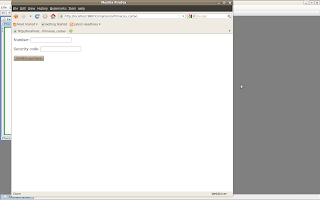The core idea is to use some Business Process (BP) Modeling tool to run, step by step, a given process representation and, at each step, excite the associated automated tests, making the system to pop-up accordingly as the user clicks on the representation. It is the same thing we see when we use tools such as Selenium, however, in that case, we would run the tests step by step and, instead of using textual descriptions of the requirements (like in BDD), we use a BP Model.
We know that there isn't a real standard for Business Process Modeling, in fact there are various, such as UML Models, Petri Nets, BPML, derivations of these etc. We also know that many EIS are based on Workflow Engines, and each of these engines has particularities. Therefore I decided to open two fronts:
1) Use a generic BP representation: the choice was Petri Nets, because I can derive others representations from them, such as Statechart and Activity Diagrams, and also there is the "Token Game", which is the simulation of the BP execution.
2) Use some workflow engine to work on top of it. The obvious choice for us was working with ERP5, an open source ERP (FOS-ERP), based on Zope, which in turn uses a state-based Wf engine, DCWorkflow. ERP5 was an obvious choice because (i) we are partners of this project since 2002, (ii) it is open, so we have access to all its code, (iii) we like state-based workflows.
I will focus now on (1) and will be back to (2) some weeks from now.
The first step for achieving (1) was to implement a proof of concept, using some Petri Nets open source tool that would be able to run Token Games, so that we could animate our model. During last August, Rodrigo Manhães, one of my associated researchers, prepared a proof of concept based on Woped.
Using an example PN, he created a very basic application, without taking care of the application logic or GUI - the goal is to show our proposal, not discuss BPM or GUI. The screenshot in Figure 1 shows the moment when the user reaches an OR-Split and must choose which path to follow in the workflow.
Figure 1: An user reaches an OR-Split in the example process
The OR-Split in Figure 1 is implemented as a list box. Appropriate tests excite this code, as shown in Figure 2.Figure 2: The equivalent test run for the OR-Split
Remember that tests "are by example", therefore, the user doesn't interact with the real system, instead, he/she is a spectator of the tests, launching them by choosing which path to follow in the PN. After checking if the system is implemented the way he/she expected, the user closes the GUI and then choose the path equivalent to Credit Card, making the test code to run this option, which, in turn, makes the form in Figure 3 to pop. Meanwhile in Woped, the user can see a message that shows which scenario was chosen, including the Given-When-Then equivalent instructions (Figure 4).
Figure 3: Credit Card data form
Figure 4: Message with equivalent GWT.
When the user clicks in OK, the flow goes to the next step, an AND-Split (Figure 5) and the tests responsible for filling the form will run, as shown in Figure 6.
Figure 5: The process enters an AND-Split
Figure 6: Running the test for filling Credit Card data
Although we had to implement specific logic for each of the PN structures (I will start discussing this on the next post of this series), the next steps for verifying the consistency between the BP model and the system are similar.
The goal of this post was to show our basic idea: make the user run the business process and see immediately how the system is behaving. If there isn't correspondence between requirements and code (originated by process change or code wrongly implemented), errors will appear, automatically indicating where the system is not compliant to the requirements described by the model. Error situations will be shown in the next posts.






Some environments, such as Oracle BPM Studio, offer similar functionality, however they are packaged solutions, usually built around a workflow engine. Here we propose a generic process, built around automated tests. Even when we propose to use a workflow engine, this engine is excited by tests.
ReplyDeleteHi Rogerio. Are you using a plugin or something like that in woped for the scenarios? Could you please provide further details on this?
ReplyDeleteHi, this was really a prototype, thus you cannot use it. We are seeking for help on making it a real tool - although we have just implemented similar functionality to ERP5 already - I will post soon.
ReplyDelete